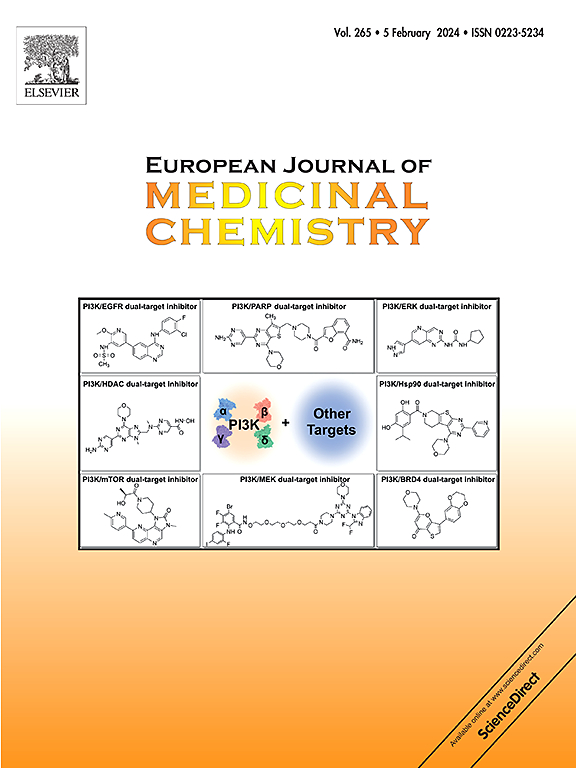Design, synthesis and bioevaluation of novel hydrazide derivatives as enhancers of immunotherapy and DNA-damage response in antitumor therapy
IF 6
2区 医学
Q1 CHEMISTRY, MEDICINAL
引用次数: 0
Abstract
We have designed and synthesized a series of novel hydrazide-based HDAC3 inhibitors, with the representative compound 8ae demonstrating potent HDAC3 inhibitory activity, having an IC50 value of 311 nM (with a selectivity index SI greater than 32 over other HDACs). Compound 8ae also exhibited significant anti-proliferative activity against five types of cancer cells, with an average inhibitory rate IC50 value of 5.036 μM, and was capable of inhibiting the migration, invasion, and wound healing activities of B16–F10 cells. Further studies revealed that 8ae effectively modulates the expression of Ac-H3 within tumor cells and can degrade PD-L1 in tumor cells through the lysosome pathway mediated by cathepsin B (CTSB). Notably, 8ae also possesses favorable pharmacokinetic properties. In in vivo experiments, the combination of 8ae with the PD-L1 inhibitor NP-19 activated the immune system in melanoma-bearing mice, leading to an enhanced anti-tumor immune response (TGI = 65 %). When combined with olaparib, 8ae significantly enhanced tumor suppressive activity (TGI = 88 %) in a breast cancer mouse model and displayed a favorable safety profile. Collectively, 8ae is a promising HDAC3 inhibitor that warrants further exploration in cancer therapeutic strategies.


新型酰肼衍生物的设计、合成和生物评估--作为抗肿瘤疗法中免疫疗法和 DNA 损伤反应的增强剂
我们设计并合成了一系列基于酰肼的新型 HDAC3 抑制剂,其中代表性化合物 8ae 具有强效的 HDAC3 抑制活性,其 IC50 值为 311 nM(与其他 HDAC 相比,选择性指数 SI 大于 32)。化合物 8ae 还对五种癌细胞具有显著的抗增殖活性,平均抑制率 IC50 值为 5.036 μM,并能抑制 B16-F10 细胞的迁移、侵袭和伤口愈合活性。进一步的研究发现,8ae 能有效调节肿瘤细胞内 Ac-H3 的表达,并能通过由 cathepsin B(CTSB)介导的溶酶体途径降解肿瘤细胞内的 PD-L1。值得注意的是,8ae 还具有良好的药代动力学特性。在体内实验中,8ae 与 PD-L1 抑制剂 NP-19 联用可激活黑色素瘤小鼠的免疫系统,从而增强抗肿瘤免疫反应(TGI = 65%)。在乳腺癌小鼠模型中,8ae 与奥拉帕利(olaparib)联用可显著增强肿瘤抑制活性(TGI = 88%),并显示出良好的安全性。总之,8ae 是一种很有前景的 HDAC3 抑制剂,值得在癌症治疗策略中进一步探索。
本文章由计算机程序翻译,如有差异,请以英文原文为准。
求助全文
约1分钟内获得全文
求助全文
来源期刊
CiteScore
11.70
自引率
9.00%
发文量
863
审稿时长
29 days
期刊介绍:
The European Journal of Medicinal Chemistry is a global journal that publishes studies on all aspects of medicinal chemistry. It provides a medium for publication of original papers and also welcomes critical review papers.
A typical paper would report on the organic synthesis, characterization and pharmacological evaluation of compounds. Other topics of interest are drug design, QSAR, molecular modeling, drug-receptor interactions, molecular aspects of drug metabolism, prodrug synthesis and drug targeting. The journal expects manuscripts to present the rational for a study, provide insight into the design of compounds or understanding of mechanism, or clarify the targets.

 求助内容:
求助内容: 应助结果提醒方式:
应助结果提醒方式:


